Wir benötigen Ihre Einwilligung zur Verwendung der einzelnen Daten, damit Sie unter anderem Informationen zu Ihren Interessen einsehen können. Klicken Sie auf "OK", um Ihre Zustimmung zu erteilen.
ASTM D5746-98(2010)
Standard Classification of Environmental Condition of Property Area Types for Defense Base Closure and Realignment Facilities
Automatische name übersetzung:
Standardklassifikation der Umwelt Zustand der Immobilie Flächentypen für Defense Base Verschluss und Neuausrichtung Einrichtungen
NORM herausgegeben am 1.4.2010
Informationen über die Norm:
Bezeichnung normen: ASTM D5746-98(2010)
Anmerkung: UNGÜLTIG
Ausgabedatum normen: 1.4.2010
SKU: NS-32363
Zahl der Seiten: 8
Gewicht ca.: 24 g (0.05 Pfund)
Land: Amerikanische technische Norm
Kategorie: Technische Normen ASTM
Kategorie - ähnliche Normen:
Die Annotation des Normtextes ASTM D5746-98(2010) :
Keywords:
Community Environmental Response Facilitation Act (CERFA), Comprehensive Environmental Response, Compensation and Liability Act, environmental baseline survey (EBS), environmental condition of property, FOSL, FOST, hazardous substance, property area type, real estate, recognized environmental conditions, remediation ^DOI: ^INDEX TERMS: Classification (standards)--environmental, Closure (of environmental facilities), Department of Defense (DoD), Environmental site assessment (ESA)
Ergänzende Informationen
| Significance and Use | ||||
|
Uses—This classification is intended for use by DoD components in order to direct EBS efforts. It is also intended for use by preparers and reviewers of environmental condition of property maps and EBS reports used to support CERFA uncontaminated parcel identifications and parcels suitable for transfer by lease or by deed. This classification should be used to facilitate standardized determinations of the environmental condition of a DoD installation's real property. Such environmental condition of property determinations are necessary to assess the progress of ongoing environmental restoration, identify areas where further response may be required, identify areas where further evaluation is necessary, and to support FOSTs and FOSLs. An environmental condition of property map, which should be prepared using this classification, provides a consolidated view of a DoD installation's environmental investigation data, including sampling information. |
||||
| 1. Scope | ||||
|
1.1 Purpose—The purpose of this classification is to define seven standard environmental condition of property area types for Department of Defense (DoD) real property at a closing military installation with respect to the requirements of the Comprehensive Environmental Response, Compensation and Liability Act (CERCLA) of 1980 Section 120(h), as amended by the Community Environmental Response Facilitation Act (CERFA) of 1992, and Section 331 of the National Defense Authorization Act for Fiscal Year 1997. As such, this classification is intended to permit a DoD component to classify property into seven area types, in order to facilitate and support findings of suitability to transfer (FOSTs), findings of suitability to lease (FOSLs), and uncontaminated parcel determinations pursuant to the requirements of CERFA. Users of this classification should note that it does not address (except where noted explicitly) requirements for appropriate and timely regulatory consultation or concurrence, or both, during the identification and use of these environmental condition of property area types. 1.1.1 Seven Recognized Standard Environmental Condition of Property Area Types—The goal of this classification is to permit DoD components to classify properties on closing DoD installations in order to support determinations of which properties are suitable and unsuitable for transfer by lease or by deed. The term “standard environmental condition of property area type” refers to one of the seven area types defined in this classification. An identification of an area type on an environmental condition of property map means that a DoD component has conducted sufficient studies to make a determination of the recognized environmental conditions of installation real property or has complied with the identification requirements of uncontaminated property under CERFA, or both, and has categorized the property into one of the following seven area types: 1.1.1.1 Standard Environmental Condition of Property Area Type 1—An area or parcel of real property where no release, or disposal of hazardous substances or petroleum products or their derivatives has occurred (including no migration of these substances from adjacent properties). 1.1.1.2 Standard Environmental Condition of Property Area Type 2—An area or parcel of real property where only the release or disposal of petroleum products or their derivatives has occurred. 1.1.1.3 Standard Environmental Condition of Property Area Type 3—An area or parcel of real property where release, disposal, or migration, or some combination thereof, of hazardous substances has occurred, but at concentrations that do not require a removal or remedial action. 1.1.1.4 Standard Environmental Condition of Property Area Type 4—An area or parcel of real property where release, disposal, or migration, or some combination thereof, of hazardous substances has occurred, and all remedial actions necessary to protect human health and the environment have been taken. 1.1.1.5 Standard Environmental Condition of Property Area Type 5—An area or parcel of real property where release, disposal, or migration, or some combination thereof, of hazardous substances has occurred and removal or remedial actions, or both, are under way, but all required actions have not yet been taken. 1.1.1.6 Standard Environmental Condition of Property Area Type 6—An area or parcel of real property where release, disposal, or migration, or some combination thereof, of hazardous substances has occurred, but required response actions have not yet been initiated. 1.1.1.7 Standard Environmental Condition of Property Area Type 7—An area or parcel of real property that is unevaluated or requires additional evaluation. 1.1.2 CERCLA Section 120(h) Requirements—This classification of environmental condition of property area types is consistent with CERCLA § 120(h) requirements relating to the transfer of contaminated federal real property (42 USC 9601 and following). Areas classified as Area Types 1 through 4, as defined in this classification, are suitable, with respect to CERCLA § 120(h) requirements, for deed transfer to a non-federal recipient. 1.1.3 CERFA Requirements—This classification of environmental condition of property area types can be used in conjunction with the reporting requirements of CERFA, which amended CERCLA (Public Law 102-426, 106 Statute 2174). As defined in this classification, areas classified as Type 1 areas are eligible for reporting as “uncontaminated property” under the provisions of CERFA. At installations listed on the national priorities list, Environmental Protection Agency (EPA) concurrence must be obtained for a parcel to be considered uncontaminated and therefore transferable under CERCLA § 120(h)(4). EPA has stated as a matter of policy that there may be instances in which it would be appropriate to concur with the military service that certain parcels can be identified as uncontaminated under CERCLA § 120(h)(4), although some limited quantity of hazardous substances or petroleum products have been stored, released, or disposed of on the parcel. If the information available indicates that the storage, release, or disposal was associated with activities that would not be expected to pose a threat to human health or the environment (for example, housing areas, petroleum-stained pavement areas, and areas having undergone routine application of pesticides), such parcels should be eligible for expeditious reuse. 1.1.4 Petroleum Products—Petroleum products and their derivatives are included within the scope of this classification. Under DoD policy, areas on which petroleum products and their derivatives have been released or disposed of may not be suitable for deed transfer until a response action has been completed. 1.2 Objectives—The objectives guiding the development of this classification are as follows: (1) to synthesize and put in writing a standard classification of environmental condition of property area types; (2) to facilitate the development of high-quality, standardized environmental condition of property maps that can be used to support FOSTs and FOSLs; (3) to facilitate the development of a standard practice for conducting environmental baseline surveys; and (4) to facilitate the development of a standard guide for preparing environmental baseline survey reports. |
||||
| 2. Referenced Documents | ||||
|
Ähnliche Normen:
Historisch
1.5.2014
Historisch
1.5.2013
Historisch
1.5.2014
Historisch
1.7.2013
Historisch
1.10.2012
Historisch
1.2.2012
Empfehlungen:
Aktualisierung der technischen Normen
Wollen Sie sich sicher sein, dass Sie nur die gültigen technischen Normen verwenden?
Wir bieten Ihnen eine Lösung, die Ihnen eine Monatsübersicht über die Aktualität der von Ihnen angewandten Normen sicher stellt.
Brauchen Sie mehr Informationen? Sehen Sie sich diese Seite an.


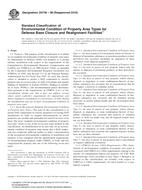
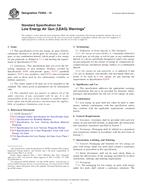 ASTM F2654-14
ASTM F2654-14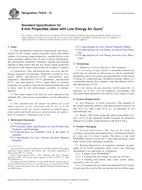 ASTM F2679-13
ASTM F2679-13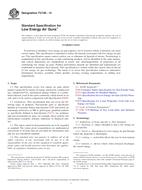 ASTM F2748-14
ASTM F2748-14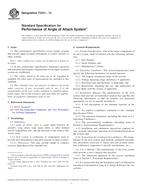 ASTM F3011-13
ASTM F3011-13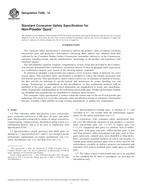 ASTM F589-12
ASTM F589-12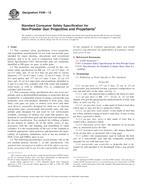 ASTM F590-12
ASTM F590-12
 Cookies
Cookies
